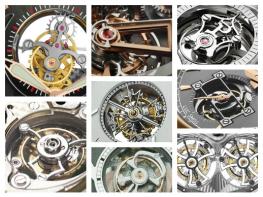A name on the dial, a logo on the crown, an engraving on the buckle: brands place their identity in a variety of spots on a watch. Whereas those kind of signatures are within everyone’s reach, there is one far more exclusive, complex and graphic kind that remains the preserve of the greatest watchmakers: the design of a tourbillon.
Bridge
While a tourbillon is composed of a large number of mostly tiny parts, two of its components are large enough to bear a distinctive inscription. The first of these is the bridge of the tourbillon, which secures the latter from above and holds it to the rest of the movement. This is often a thin bar on which a considerable amount of finishing is lavished, including polishing, bevelling and sometimes the operation known in French as berçage, which involves rounding off the profile. In some rarer cases, such as at Chopard, the tourbillon bridge adopts a special shape – in this instance a large rectangular frame that is as slim as possible so as not to obstruct the view of the tourbillon’s rotations. There are however two instances in which this particular bridge cannot be personalised. The first is when it is made from a transparent sapphire disc, an increasingly popular option used for example by Bulgari. The other is on flying tourbillons – and with good reason, since they by definition have no tourbillon bridge!

Cage
Fortunately, there is always another essential functional part that lends itself to specific designs: the cage (or carriage). This is the component that contains the watch escapement and enables it to be set into motion. It is the rotating vehicle of the balance wheel, and like any self-respecting vehicle, it has its own unique appearance. While remaining as light and thus as slim as possibly can be, the cage design corresponds to three types of approach. The first is historical and tends to be used by brands that have maintained uninterrupted production over decades or even centuries, such as Girard-Perregaux. The second is ultra-functional and based mainly on weight-saving, as adopted by Audemars Piguet with its ultra-slim ‘three-pointed’ star. The third and last is a more recent trend stemming from the branding culture that is gaining ground among a number of companies, where the brand logo becomes the actual shape of the cage, in which Cartier has housed its capital C, Piaget its P and Vacheron Constantin its Maltese cross symbol.

Beauty
Apart from the above-mentioned categories, there are also designs that come with no strings attached and are chosen for the sheer beauty of their appearance. Christophe Claret uses an old-fashioned folded trefoil motif in tribute to the age of classical horology; A. Lange & Söhne has its three branches tipped with sabre guards, combining an appealing visual effect with functional rigidity; while Roger Dubuis uses a triskel shape providing a large smooth surface particularly well suited to polishing. Part of the very mission of these cases is indeed to provide a playground for the most exclusive finishes, since the tourbillon naturally belongs to this realm of extreme aesthetic refinement.

To open the slideshow, click on the large image at the top of the page.









